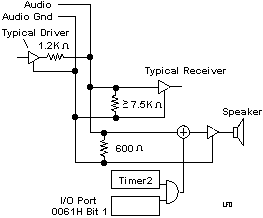|
Driving Linear Amp Input Node The audio subsystem is a speaker driven by a linear amplifier. The linear amplifier input node can be driven from the following sources: Tone Generator (timer 2) output Enabled using bit 1 of I/O port 0061h set to 1. (For information about timer 2 see Programmable Timers.)
System Channel, using the 'audio sum node' signal. Audio Subsystem Block Diagram
Each audio driver must have a 1200-ohm source impedance,
and
The logic ground is connected to AUDIO GND at the amplifier. Single channel analog audio signal . Synthesized voice or music generated
on a Micro Channel adapter can be routed as a complex analog waveform directly
to the amplifier and speaker inside the computer. The Micro Channel allows
expansion cards on the channel to exchange and independantly process audio
signals.
Audio Signal Group
Audio Sum Node (Signal pin B02)
Audio Gnd (Signal Pin B01)
|
